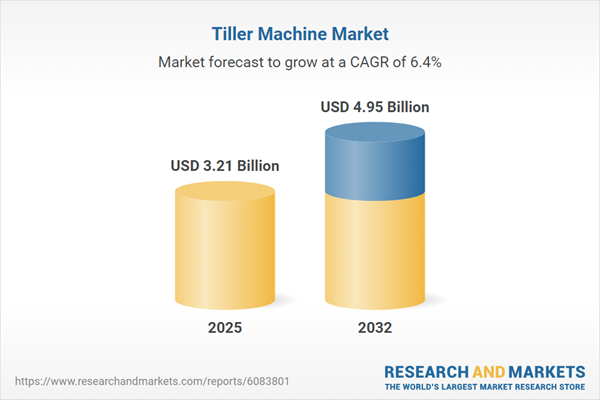Speak directly to the analyst to clarify any post sales queries you may have.
The tiller machine market is undergoing significant transformation as new technologies, regulatory shifts, and evolving user needs drive innovation and strategic investment across the value chain. The following analysis provides senior decision-makers with a focused, data-driven overview of market dynamics, technological trends, and actionable pathways to optimize growth and operational efficiency.
Market Snapshot: Tiller Machine Market Size and Growth
The global tiller machine market grew from USD 3.02 billion in 2024 to USD 3.21 billion in 2025. It is projected to continue its upward trajectory at a CAGR of 6.35%, reaching an estimated USD 4.95 billion by 2032.
This sustained growth reflects ongoing demand for advanced cultivation equipment, rising labor shortages, and the integration of connected solutions within modern agricultural operations.Scope & Segmentation
Executive leaders require a comprehensive perspective on the segments shaping the tiller machinery landscape. This report analyzes market dynamics through the following coverage areas:
- Tine Type: Double and single tine models tailored for varying soil conditions and workload intensity.
- Power Source: Electric, gasoline, and manual variants designed to meet diverse operational, regulatory, and environmental requirements.
- Engine Power: Less than 5 Hp, 5–10 Hp, and greater than 10 Hp solutions serving applications from residential gardening to intensive agricultural contracting.
- Application: Agricultural (orchard, row cropping), commercial (landscaping, rental services), and residential (garden, lawn) settings necessitating specific features and design approaches.
- Distribution Channel: Offline (distributors, retail stores) and online (e-commerce platforms, manufacturer websites) channels, each with tailored marketing and logistics needs.
- Regions: Americas (including United States, Canada, Mexico, Brazil, Argentina, Chile, Colombia, Peru), Europe, Middle East & Africa (from United Kingdom and Germany to South Africa and Kenya), and Asia-Pacific (China, India, Japan, Australia, South Korea, Indonesia, and others).
- Major Companies: Industry coverage includes AGCO Corporation, Deere & Company, Kubota Corporation, Mahindra & Mahindra Ltd., Honda Motor Co., Ltd., Yanmar Co., Ltd., Husqvarna AB, KUHN GROUP, CNH Industrial Group, and BCS America LLC.
Key Takeaways for Senior Decision-Makers
- Electrification and integration of digital monitoring platforms are rapidly transforming traditional tilling equipment into connected, low-emission assets suitable for both large-scale and smallholder operations.
- Segment-specific design—such as tine configuration, engine capacity, and attachment compatibility—drives differentiation, allowing manufacturers to offer tailored solutions for commercial, agricultural, or residential customers.
- Geographic variations in regulatory requirements, customer preferences, and distribution infrastructure necessitate localized product strategies to remain competitive and compliant in diverse markets.
- Advanced service and revenue models, including rental platforms and usage-based billing, are lowering entry barriers and enabling access to premium equipment among smaller or cost-sensitive operators.
- Collaborative initiatives with software developers and component suppliers are fostering innovation, expediting product development, and enhancing predictive maintenance and service capabilities across the sector.
- Sustainable engineering and modular design principles are optimizing resource use and facilitating customized solutions, positioning brands to address tightening environmental expectations.
Tariff Impact and Supply Chain Adaptation
Recent U.S. tariff policies have increased import costs for tiller machines and components, challenging established supply chains. In response, industry leaders are diversifying supplier networks, pursuing local and regional partnerships, and investing in inventory management and trade compliance to reduce risk and maintain profitability. Vertical integration initiatives and domestic assembly are also being prioritized to mitigate future policy-induced disruptions.
Research Methodology & Data Sources
This report employs primary research through executive interviews at leading manufacturers, distribution firms, and agricultural cooperatives, complemented by secondary research from technical journals, industry associations, and regulatory publications. Quantitative analysis is validated using expert triangulation and scenario-based modeling frameworks to ensure data reliability and relevance.
Why This Report Matters
- Enables executive teams to align R&D, supply chain management, and market entry tactics with current trends and forward-looking opportunities.
- Empowers informed decision-making by presenting actionable insights on segmentation, competitive positioning, and region-specific demand drivers in the tiller machine market.
- Supports strategic planning through a validated synthesis of qualitative and quantitative findings on technology adoption, policy impacts, and emerging service models.
Conclusion
The global tiller machine market is entering a period of dynamic change led by innovation, regulatory pressures, and expanding applications. Equipped with granular insights presented here, decision-makers can harness the right strategies to realize operational excellence and unlock new sources of value in this evolving landscape.
Table of Contents
3. Executive Summary
4. Market Overview
7. Cumulative Impact of Artificial Intelligence 2025
Companies Mentioned
The companies profiled in this Tiller Machine market report include:- AGCO Corporation
- Deere & Company
- Kubota Corporation
- Mahindra & Mahindra Ltd.
- Honda Motor Co., Ltd.
- Yanmar Co., Ltd.
- Husqvarna AB
- KUHN GROUP
- CNH Industrial Group
- BCS America LLC
Table Information
| Report Attribute | Details |
|---|---|
| No. of Pages | 183 |
| Published | November 2025 |
| Forecast Period | 2025 - 2032 |
| Estimated Market Value ( USD | $ 3.21 Billion |
| Forecasted Market Value ( USD | $ 4.95 Billion |
| Compound Annual Growth Rate | 6.3% |
| Regions Covered | Global |
| No. of Companies Mentioned | 11 |









